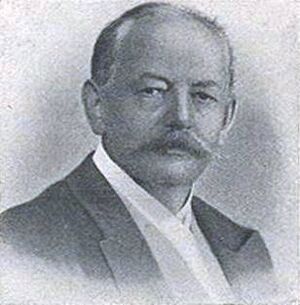Adolf Engler facts for kids
Quick facts for kids
Adolf Engler
|
|
|---|---|
 |
|
| Born |
Heinrich Gustav Adolf Engler
25 March 1844 |
| Died | 10 October 1930 (aged 86) |
| Nationality | German |
| Alma mater | University of Breslau |
| Known for | Die Natürlichen Pflanzenfamilien |
| Awards | Linnean Medal (1913) |
| Scientific career | |
| Fields | Botany, plant taxonomy |
| Institutions | Botanical Institute of Munich University of Kiel University of Berlin |
| Author abbrev. (botany) | Engl. |
Heinrich Gustav Adolf Engler (born March 25, 1844 – died October 10, 1930) was an important German botanist. He is famous for his work on how plants are classified (called plant taxonomy). He also studied where plants grow around the world (called phytogeography).
One of his most well-known works is Die natürlichen Pflanzenfamilien (The Natural Plant Families). He worked on this huge project with Karl A. E. von Prantl.
Even today, many plant collections (called herbaria) still use his system for classifying plants. Many books and guides about plants also follow his ideas. His system is special because it tries to classify all "plants." This includes everything from tiny algae to large flowering plants.
Engler wrote many books and articles about plant classification. He worked with talented artists to illustrate his books. One artist, Joseph Pohl, created over 33,000 drawings for Die naturlichen Pflanzenfamilien. Pohl also illustrated other important books like Das Pflanzenreich.
Contents
Who Was Adolf Engler?
Adolf Engler was born on March 25, 1844. His birthplace was Sagan, Silesia, which is now Żagań in western Poland. He passed away in Berlin, Germany, on October 10, 1930.
He went to the University of Breslau (now Wrocław, Poland). He earned his PhD there in 1866. After teaching for a few years, he started working at the Botanical Institute of Munich in 1871. He was in charge of the plant collections there.
In 1878, Engler became a professor at the University of Kiel. He taught about plant classification. He also became a member of the German Academy of Natural Scientists Leopoldina. In 1884, he returned to Breslau. He became the director of the Botanical Garden there. He also became a professor of botany at the University of Breslau.
From 1889 to 1921, Engler taught at the University of Berlin. He also directed the Berlin-Dahlem Botanical Garden. He helped make it one of the best botanical gardens in the world. Engler traveled to many parts of the world. His trips helped him learn more about where different plants grow, especially in Africa.
Engler's Important Plant Studies
Adolf Engler was a master at plant taxonomy. This is the science of identifying, naming, and classifying plants. He was especially good at studying certain plant groups. These included Saxifraga, Araceae, and Burseraceae.
He worked with other famous botanists on big projects. He helped Alphonse de Candolle with Monographiae Phanerogamarum. This book was about flowering plants. He also worked with C.F.P. von Martius on Flora Brasiliensis. This huge work described the plants of Brazil.
Engler also started a science journal in 1881. It was called Botanische Jahrbücher für Systematik, Pflanzengeschichte und Pflanzengeographie. This journal is still published today. Its name changed in 2010 to Plant Diversity and Evolution.
Major Books on Plant Families
- Die Natürlichen Pflanzenfamilien (The Natural Plant Families): Engler edited this massive work with Karl A. E. Prantl. Many other experts helped too. It was published from 1887 to 1915 and had 23 volumes. This series is one of the few detailed works that tries to classify all plants. It covers everything from algae to flowering plants. It is a very valuable resource for botanists. A second edition was also started, but it was never fully finished.
- Das Pflanzenreich (The Plant Kingdom): This series focused on specific plant groups. Many experts worked on it with Engler. It was published from 1900 to 1968. This huge project is still not complete.
- Syllabus der Pflanzenfamilien : This book was first published in 1892. It is a summary of the Engler system of plant classification. The most recent edition was published between 1954 and 1964. It describes the higher levels of plant classification in two volumes.
Studying Plant Geography
Engler was a pioneer in phytogeography. This is the study of where plants grow and why they grow there. He showed how things like geology (the study of Earth's rocks and soil) affect where different plants are found. In 1879, he helped define different biogeographical regions.
- Vegetation der Erde (Vegetation of the Earth): He wrote this book in 1896 with O. Drude.
- Die Pflanzenwelt Ost-Afrikas und der Nachbargebiete (The Plant World of Eastern Africa and the Adjacent Regions): This book, published in 1895, focused on plants in East Africa.
How Engler Was Honored
Adolf Engler received the Linnean Medal in 1913. This is a very important award in botany. In 1986, the International Association for Plant Taxonomy created the Engler Medal. This medal is given to people who make great contributions to plant taxonomy.
Engler was also chosen as a member of several important groups. These included the American Philosophical Society and the Royal Netherlands Academy of Arts and Sciences. He also became an International Member of the United States National Academy of Sciences.
The journal Englera is published by the Berlin-Dahlem Botanical Garden. It is named after him. Many plant genera (groups of related plants) are also named in his honor. Some examples include Englerarum, Engleria, and Englerophytum. Two genera of fungi are also named after him: Engleromyces and Englerodothis.
The specific plant name adolphi also honors him.
See also
 In Spanish: Adolf Engler para niños
In Spanish: Adolf Engler para niños
- Engler system
- List of plants of Caatinga vegetation of Brazil
- List of plants of Cerrado vegetation of Brazil
- Phylogenetic system




